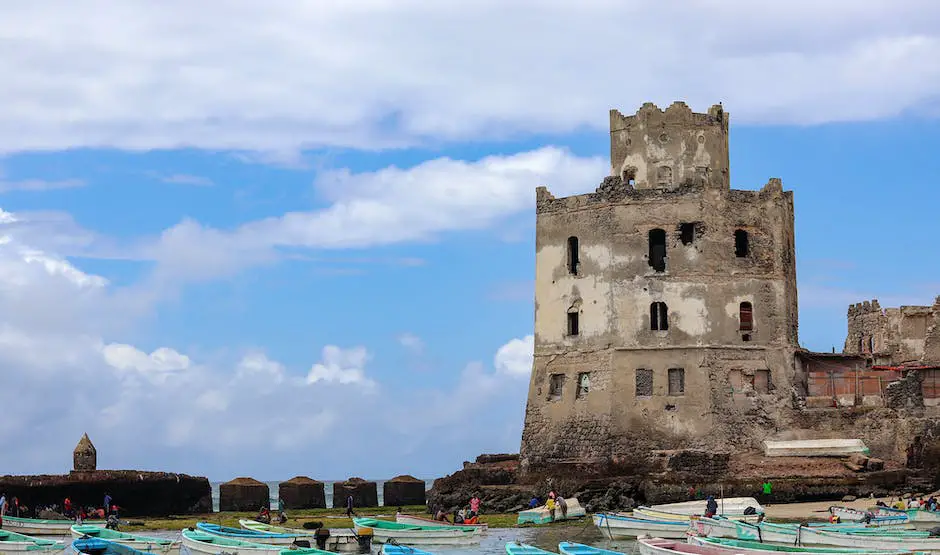
Mogadishu, the vibrant heart of Somalia, has a rich tapestry of history woven into its urban fabric. Its architecture tells a story of resilience and transformation, a narrative that has seen the city rise, fall, and rise again. As I stroll through the bustling streets, I can’t help but marvel at the eclectic mix of structures that reflect a past marked by foreign influences and a present striving towards rebirth.
The Roots of Mogadishu’s Architectural Heritage
The city’s architectural journey began with the influence of Arab and Persian traders, who left their mark with coral stone buildings and ancient mosques. The Arba’a Rukun Mosque, for instance, stands as a testament to the 13th-century Islamic architecture that still dots the cityscape. These structures, with their minimalist elegance, are a reminder of a time when Mogadishu was a thriving hub of the Indian Ocean trade.
Colonial Imprints on the Cityscape
The turn of the 20th century brought European colonial powers to Somali shores. Italian rule introduced neoclassical and art deco styles, evident in buildings like the Cathedral of Mogadishu. These grand edifices, with their imposing facades, were a stark contrast to the local architectural vernacular. They symbolized a new era, one where Mogadishu was dressed in the architectural trends of Europe.
Post-Colonial Ambitions and Modernist Movements
Independence in 1960 ushered in a period of optimism and modernization. Mogadishu embraced modernist architecture, with its clean lines and functional design. The National Theatre of Somalia, built in the 1960s, is a relic of this era, showcasing the forward-thinking attitude that permeated the city. It was a time of hope, where architecture mirrored the nation’s aspirations for progress.
The Impact of Civil War on Mogadishu’s Built Environment
Sadly, the onset of civil war in the 1990s scarred the city’s landscape. Many historic buildings were reduced to rubble, and the city’s architectural evolution was brutally interrupted. Walking through Mogadishu today, the remnants of war are visible in the bullet-riddled walls of once-magnificent structures. Yet, amidst the destruction, the resilient spirit of Mogadishu’s people shines through.
A New Chapter: Rebuilding and Restoration
In recent years, there’s been a concerted effort to restore Mogadishu’s architectural glory. New buildings rise from the ashes, blending traditional Somali styles with modern aesthetics. The Turkish Embassy, for example, is a symbol of international cooperation and the city’s ongoing revival. It’s a blend of the old and new, much like Mogadishu itself.
Preserving the Past While Building the Future
The challenge now is to preserve the architectural heritage while accommodating growth. Initiatives to restore historic buildings, such as the iconic Uruba Hotel, are underway. These projects are crucial in keeping the city’s history alive for future generations. They serve as a bridge between the Mogadishu of yesteryears and the burgeoning metropolis it aspires to become.
FAQs About Mogadishu’s Architecture
What are some iconic examples of Mogadishu’s historical architecture?
The Arba’a Rukun Mosque and the Garesa Museum, formerly a palace, are prime examples of Mogadishu’s rich architectural history. They showcase the Islamic influence and the city’s role as a historical trade center.
How did the civil war affect Mogadishu’s architecture?
The civil war led to widespread destruction of Mogadishu’s infrastructure. Many historic buildings were damaged or destroyed. However, the city is undergoing a process of rebuilding and restoration, signaling a new era of hope.
Are there any preservation efforts for Mogadishu’s historic buildings?
Yes, there are ongoing efforts to restore and preserve Mogadishu’s historic buildings. International partnerships and local initiatives are playing a key role in these conservation projects.
Conclusion: A City in Transformation
Mogadishu’s architecture is a mirror reflecting its tumultuous history and its resilient spirit. From the ancient mosques to the Italianate buildings, each layer adds depth to the city’s story. The scars of war are still visible, but so is the determination to rebuild and restore. As the city continues to evolve, its architecture remains a testament to the past while embracing the promise of a brighter future. For those of us who’ve walked its streets and witnessed its revival, Mogadishu stands as a beacon of hope, a city that refuses to be defined by its trials but rather by its enduring strength and beauty.
In crafting this narrative, I’ve woven together the threads of Mogadishu’s architectural evolution, from its early Islamic influences to its modern-day reconstruction. It’s a tale of a city that has stood the test of time, bearing witness to the ebb and flow of fortunes. For those looking to understand the essence of Mogadishu, its architecture is a good place to start. It’s a story etched in stone and mortar, waiting to be explored and appreciated.